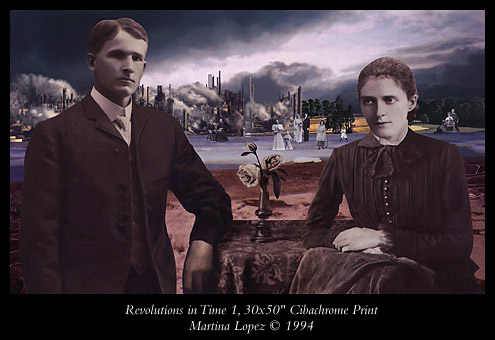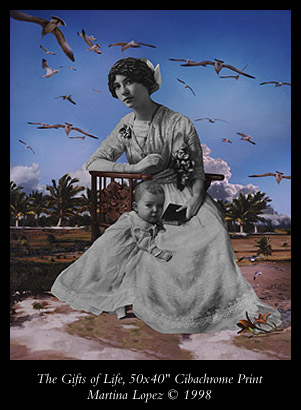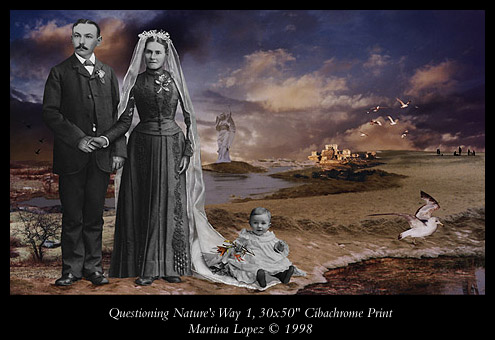

DIGITAL ALLEGORY
Martina Lopez
In later images Lopez began to incorporate found photographs and images taken from family albums other than her own. In doing so the artist created works which reflected her own thoughts and experiences, but also allowed the viewer to bring their own interpretations and memories into the work. The turn-of-the-century photographic studio portraits which figure prominently throughout Lopez's work evoke a resonance to our own individual memories of family and past experiences. The rigid and contrived poses and settings which were common in photographers' studios of that period often mirror our own personal photographic archives of familiar faces and distant relations who, although disconnected by the passage of time, are linked by memory or through stories which have been passed down over generations. These photographs then become a mnemonic for a specific memory where an image of a birthday party, a wedding, or an individual duplicating a gesture, or wearing a familiar outfit, or standing in a recognized place provokes a synchronous recollection in our own lives.

The figures in Lopez's images vary in scale and placement within each scene and are rendered in monochromatic tones so they seem to have no direct connection to the fabricated landscapes they occupy. The surreal landscapes, composed of disjointed topographies that are appropriated from other sources and from photographs made specifically for the piece, become a stage setting in which the placement of each character is carefully choreographed. The large scale of Lopez's work, often up to 40 x 60 inches, is a key element in their interpretation. At a distance we consider the relationship between the primary characters in each image, as we move closer we become aware of the secondary characters in the scene and ponder their role in the landscape. When these large panels are placed together they begin to be read as individual segments of a much larger story similar to other allegorical works of art throughout history from ancient pictographs, to Medieval tapestries, to Renaissance frescos, to contemporary murals which visually compress accounts of great epics and significant events onto a single two dimensional plane.

In the most recent works presented in this exhibition the artist looks back to a very emotional year which saw the death of one of her brothers and the birth of her first child. She writes, "This blatant exchange of life and death made me question many things, the intangible human spirit, the miracle of birth, the passage of death, nature's role of the mother, and my own inner conflict of independence and the dependent child." For Lopez the foundation of each series is autobiographical, but also states that "the specific stories are not necessary to understanding the work, but they are what drive their creation. My images have become a visual diary, a place where I come to terms with life." In her computer-assisted images Lopez presents us with an intricate mosaic fashioned from millions of individual pixels that create an allegory of life, death, and nostalgia, and like the memories and the photographs they reference, her images exist in their own temporal state.
Gary Hesse,
Associate Director, Light Work